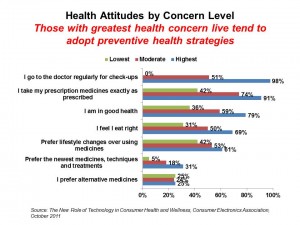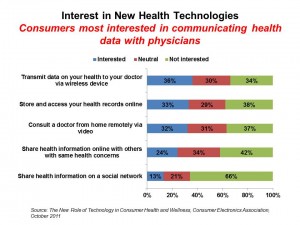 More people with higher levels of concern about their health feel they are in good health, see their doctors regularly for check-ups, take prescription meds “exactly” as instructed, feel they eat right, and prefer lifestyle changes over using medicines.
More people with higher levels of concern about their health feel they are in good health, see their doctors regularly for check-ups, take prescription meds “exactly” as instructed, feel they eat right, and prefer lifestyle changes over using medicines.
And 40% of these highly-health-concerned people have also used a health technology in the past year.
At the other end of the spectrum are people with low levels of health concern: few see the doctor regularly for check-ups, less than one-half take their meds as prescribed by their doctors, only 31% feel they eat right, and only 36% feel they’re in good health.
While roughly one-fourth to one-third of U.S. adults have been early adopters of consumer technologies in general across low-moderate-and-high health concern segments, more of those with greater health concerns tended to use health tech products in the past twelve months: 40% of the highest concerned people vs. 25% of those with moderate health concerns and 14% of those at the lowest-concern level.
These insights are discussed in a report, The New Role of Technology in Consumer Health and Wellness from the Consumer Electronics Association (CEA), published in October 2011.
CEA indexed U.S. adults’ “health concern levels:” people with highest levels of health concerns make up 21% of the U.S. adult population; people with moderate concerns comprise the bulk of the citizenry, 64%; and, people with low levels of health concerns aggregate to 15% of U.S. adults, based on responses to 3 key questions:
- I feel I am in good health (agree with statement)
- I go to the doctor regularly (agree with statement)
- Evaluation of current physical fitness (self-rated on excellent to very poor scale).
 The most popular health technologies demanded by U.S. adults are those that measure the body’s vital signs, including blood pressure and heart rate, desired by 40% of people; as well as digital weight scales, in demand by 44% of people. Beyond weight, heart disease is top-of-mind for consumers thinking about health technologies used at home.
The most popular health technologies demanded by U.S. adults are those that measure the body’s vital signs, including blood pressure and heart rate, desired by 40% of people; as well as digital weight scales, in demand by 44% of people. Beyond weight, heart disease is top-of-mind for consumers thinking about health technologies used at home.
CEA also found that people are interested in communications technologies that help them share personal health information with physicians: 36% of U.S. adults said they’d like to send health data to a doctor via a wireless device, and 32% would be willing to consult their doctor via video (i.e., telemedicine). Consumers are most willing to share their data with physicians, followed by a health provider, and technology manufacturer. Willingness to share data with government or app/software developers is lower, depending on the type of data being shared such as food allergies vs. heart rate, blood glucose, or fitness/exercise performance.
Physicians are also important in this study because they’re the #1 source of information on health technologies for 51% of people who use health technology. Those who do not look to commercials on TV for information, followed by physicians and friends, family and co-workers. For users of health tech, health related websites such as WebMD are also useful, as well as articles in magazines and newspapers, Internet news sites, and health publications.
The lowest concern health segment is also the group who is most concerned about their smoking — their #1 health issue. For people in the other two segments, key health concerns are seasonal allergies, sleep difficulties, high blood pressure, cholesterol and smoking. Weight loss is a top 5 concern for all 3 segments — perhaps why digital weight scales are cited as a health tech in demand. That, and peoples’ familiarity with scales for time immemorial, contribute to scales’ popularity. Related to weight, 35% of people say they’d like to see a device or service that analyzes or tracks the nutritional content of their food.
In particular, people are interested in body weight scales that record weight loss/gain over time, and meters and gauges designed to measure vital signs. 1 in 4 people like the idea of devices and services that remind them when to take their medications, and 1 in 3 like sleep monitoring tools.
The report is based on a survey conducted among 1,679 U.S. adults age 18 and over, conducted online in September 2011. In addition, CEA conducted qualitative research via 60 in-depth online interviews.
Health Populi’s Hot Points: The title of the press release for this study reads, “CEA Study Finds Wireless Health Tech in Demand; Consumers Seek Electronics Health and Fitness Devices and Mobile Apps.”
Digging into the demographics and nuances, my response to the CEA is, “Well, yes and no.”
Looking at the segment of U.S. adults with the lowest level of health concerns, these people tend to undertake lower levels of preventive health choices as well, such as eating a low fat diet (only 7% do so), regularly exercise (44% compared with 64% of the highest concerned people), maintain healthy blood pressure (only 15%), get a good night’s sleep (40%), and see a doctor regularly for check-ups (only 9%, compared with 82% of the highest concerned and 43% of the moderately concerned).
If healthy food is a prerequisite for whole health, then the lowest-health-concerned segment is at a health deficit: while only 26% say they eat more vegetables, 90% of the highest concerned segment eat more greens, and 58% of the moderately concerned do so.
The lower health concerned folks are also less affluent than people more activated about their health; they’re also younger, and more are single. However, they tend to have as many kids in their households as people with higher levels of concerns for health.
Thus the headline, “Consumers Seek Electronics Health and Fitness Devices and Mobile Apps” tells the story for only some consumers, and only some devices and apps.
Note in the second chart that only 13% of people are interested in sharing their health information on a social network, and only 24% want to share information with other “patients like me” — people with the same health concerns.
Furthermore, there are no data yet that show that downloaded mobile health apps are universally used and sustained over time once downloaded.
Beyond weight scales, glucose meters and blood pressure cuffs, health technologies and apps are quite new to mainstream America — the 64% and beyond identified in this study as “moderately health concerned” and those with lowest levels of health concern — who may be those who are in most need of home monitoring and tracking observations of daily living.
Once again, the health provider, physician, nurse practitioner, and pharmacist play key trusted roles in communicating information about these technologies. But what are their incentives to do so?
Changing payment regimes, such as bundling, pay-for-performance, accountable care and medical homes would create incentives for those providers to educate patients on these devices — and for health plans and ACOs to actually reimburse or provide these devices to keep people well 24×7 — and outside of the doctor’s office or, worse, avoiding the emergency room or hospital readmission.
The opportunity here is for consumer electronics companies to come together with health providers, patients and software developers in a kumbayah of prevention and wellness. Take a look at what the Consumer Technology Innovations Center at Meridian Health and the Center for Connected Health are doing, for example, and you’ll get a sense of what’s possible in connecting people and providers.




 Interviewed live on BNN Bloomberg (Canada) on the market for GLP-1 drugs for weight loss and their impact on both the health care system and consumer goods and services -- notably, food, nutrition, retail health, gyms, and other sectors.
Interviewed live on BNN Bloomberg (Canada) on the market for GLP-1 drugs for weight loss and their impact on both the health care system and consumer goods and services -- notably, food, nutrition, retail health, gyms, and other sectors. Thank you, Feedspot, for
Thank you, Feedspot, for  As you may know, I have been splitting work- and living-time between the U.S. and the E.U., most recently living in and working from Brussels. In the month of September 2024, I'll be splitting time between London and other parts of the U.K., and Italy where I'll be working with clients on consumer health, self-care and home care focused on food-as-medicine, digital health, business and scenario planning for the future...
As you may know, I have been splitting work- and living-time between the U.S. and the E.U., most recently living in and working from Brussels. In the month of September 2024, I'll be splitting time between London and other parts of the U.K., and Italy where I'll be working with clients on consumer health, self-care and home care focused on food-as-medicine, digital health, business and scenario planning for the future...